Main Menu
Latest Blog Entry
User login
Force, power or acceleration?
“What is power?”
Was my opening question at yesterday’s Continuing Professional Development (CPD) workshop for strength and conditioning coaches.
“Force times velocity” was the text book response from the ex- students.
They are of course technically correct, but how does this affect how we train our athletes? What about momentum, force, impulse, velocity, mass and acceleration?
Powerlifters are powerful (high force, low velocity) as are gymnasts (low force, high velocity). Most sports people fall somewhere in between these extremes, or use different parts within their sport.
Applying power
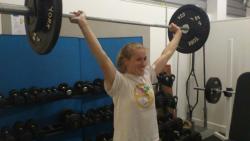 The workshop was split into three parts:
The workshop was split into three parts:
- Terminology and theory: I went through this in some detail and based it on questions I have been asking since I saw Jack Blatherwick present two years ago at GAIN (see below).
- Practical exercises to develop acceleration. This included detail look at the snatch and assistant exercises to help develop the snatch. I also covered runs, jumps and throws for the “application” cornerstone.
- Programme design: the coaches had prepared a 4 week programme to develop power and they shared and discussed this in small groups.
(One interesting question came up: velocity is a vector quantity, it has a direction. If power was force times speed, then the direction of travel would be irrelevant. So, if we develop power in one direction, why would that apply in another?)
“What are the best ways to train for acceleration of body weight?”
As part of my preparation for the workshop I trying to find research that was both current and measured what we are trying to train (rather than some abstract concept only lab technicians are interested in).
I contacted Jack Blatherwick hoping he might point me in the right direction, instead he was kind enough to respond with his thoughts:
Coaches: Trust your logic. Some research and propaganda is misleading.
I do not want to leave the impression that a coach should avoid research. Read everything you can, but do it knowing there is likely to be something incorrect or misleading along with those things that are helpful.
There’s something good in every article, even the worst pseudoscience … but misleading information is quite prevalent in current popular thoughts about Power and Force.
Acceleration = Speed, Quickness, and Agility
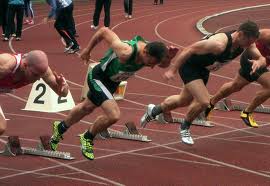 What is ‘Acceleration?’ In kinematics (the most basic topic in Physics, dealing with movement), ‘Acceleration’ is defined as any change in velocity, encompassing all changes in direction and speed.
What is ‘Acceleration?’ In kinematics (the most basic topic in Physics, dealing with movement), ‘Acceleration’ is defined as any change in velocity, encompassing all changes in direction and speed.
Agility is included in this definition, because we associate agility in sports with quick changes in direction, like cutting sharply to dodge around an opponent, or perhaps cornering at high speed on the hockey rink.
Speed is also included, because even at relatively constant speed, there is deceleration and acceleration with each stride. Horizontal acceleration of body weight is therefore one of the highest priorities in sports that feature
speed, quickness, and agility.
In other words, for this priority, the critical question is: “What are the best ways to train for acceleration of body weight?”
However, for some reason, throughout history, coaches asked for research on Force and Power, and this has led to training advice that might not be the best fit for acceleration of body weight.
Kinetics
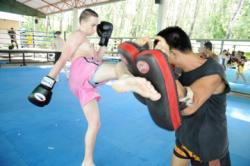 Their question seems entirely logical, and advances the discussion to ‘Kinetics,’ the second basic topic in physics, because we are certainly accelerating a mass.
Their question seems entirely logical, and advances the discussion to ‘Kinetics,’ the second basic topic in physics, because we are certainly accelerating a mass.
Therefore, Force and Power would seem to be logical extensions of our question: “What are the best ways to train for acceleration of body weight?”
But … it is an absurd thought (which no one intended) that nerves and muscles might understand the following abstractions:
- Force = Mass x Acceleration
- Power = Energy Expenditure / Time = Work / Time = Force x Distance / Time = Force x Velocity
Nerves and muscles only understand (and remember!):
- (a) how fast they have been trained.
- (b) through what range of motion.
- (c) how much effort this takes.
That is called SPECIFICITY, the principle that performance is enhanced when the training ‘looks and feels’ like the desired outcome (my simplistic definition, not to be blamed on anyone else).
Therefore, if ACCELERATION is a priority for our sport, and we use the abstraction (F=ma) we are not violating any formulas from physics … but we might be wrong.
Consider the continuum (Force = Mass x Acceleration) that represents various speeds and weights, along which we might choose our training exercises:
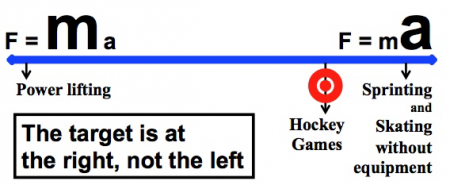
The thought is that to improve acceleration we must increase Force, and strength coaches love to do this by increasing the mass we lift in the weight room. But, of course, the more mass we lift, the slower the acceleration. Might this be considered a good way to train for slow acceleration?
Please don’t misunderstand my purpose. I believe in lifting weights – sometimes heavy weights, at an appropriate age and level of fitness. But, it is obvious that we must also incorporate more training in which we accelerate our body mass as quickly as we can.
Complex Training
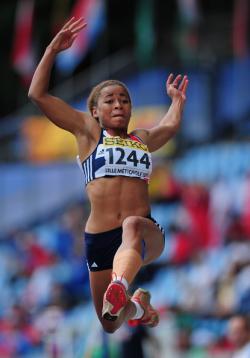 Furthermore, in every weightlifting exercise, there is a deceleration (to zero velocity) toward the end of the range of motion. This occurs at precisely the moment when sprinting and skating require an explosive acceleration.
Furthermore, in every weightlifting exercise, there is a deceleration (to zero velocity) toward the end of the range of motion. This occurs at precisely the moment when sprinting and skating require an explosive acceleration.
Considering that we are ALWAYS forming neuromuscular habits when we train, there should NEVER be a phase of the year in which we exclude quick acceleration from the program, and just work on strength.
In fact, I believe every strength exercise should be accompanied in some way with an explosive exercise featuring acceleration: jumps, weighted jumps, sprints, hills, sleds.
Neuromuscular learning occurs with every movement. Myelin is being formed along axons which innervate muscle fibres that are training at high speed.
Timing is a critical part of athletic development, and slow training – if overdone – will certainly not enhance quickness, agility, and speed.
Peak power?
The simplest word (acceleration) for our highest priority has been needlessly replaced by Force and Power.
The word ‘POWER’ has so many colloquial uses that it is often misinterpreted in communications between the physics (biomechanics) lab and the important group of users: athletes and coaches.
One question that has been examined for decades is: “What is the optimum amount of weight to be incorporated into a training exercise to maximize power?” Research is inconclusive, but many believe the optimum weight should be about 30% of a maximum lift with one repetition (1RM).
How important is this question for sports that depend on speed, quickness, and agility?
If the question had been: “What is the optimum weight to lift to maximize ACCELERATION?” The answer is “Zero. Just use bodyweight.”
Many coaches and athletes (as well as scientists and professors) incorrectly believe that explosiveness or explosive starts from a standstill are where athletes demonstrate the greatest power, like exploding out of the starting blocks.
But, looking at the equation Power = Force x Velocity, it is easy to see that there needs to be substantial velocity for Power to be a maximum. Of course there also needs to be a high rate of acceleration as well,because Force = mass x acceleration (F=ma).
Think of it this way: If an athlete accelerates at the same rate between zero and 5 miles per hour as he does between 5-10 mph, his Power is greater from 5-10, because velocity is greater.
Usain Bolt’s graph of velocity vs. time (modified from IAAF data), demonstrates this point clearly.
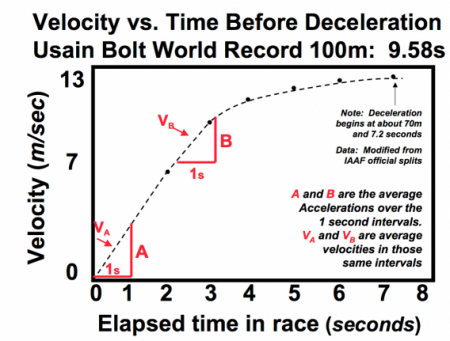 His maximum power does not occur at the start. That is where acceleration is greatest. Power does not peak until a couple of seconds into the sprint where both acceleration and velocity are high.
His maximum power does not occur at the start. That is where acceleration is greatest. Power does not peak until a couple of seconds into the sprint where both acceleration and velocity are high.
Explosive movement from a standstill is not where an athlete expresses peak power. When we observe a dragster take off at the start, it is common to use the word ‘powerful.’ But the dragster exerts much greater power somewhere later in the race.
Training Programme Design
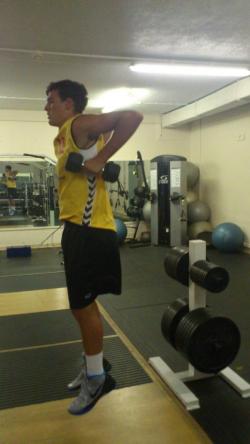 ACCELERATION is the correct and simplest word for quickness and agility, and this is the highest priority in many sports, except where the athlete has to move large external masses.
ACCELERATION is the correct and simplest word for quickness and agility, and this is the highest priority in many sports, except where the athlete has to move large external masses.
In designing training programs, keep in mind the objective. If the athlete needs to accelerate his own body weight to be successful, there should be a lot of that in training programs.
Heavy strength training is slow acceleration. That does not mean it is wrong, but it must be accompanied by the fast acceleration of body weight (as seen in the video below of midfielder, Sam Malcolm: note the single-leg landing and push-off).
Jack Blatherwick
Thanks very much to Jack for that excellent advice. We kept touching upon training principles yesterday: coaches like doing what they are comfortable with as well as what the physical constraints of their “weights room” dictates.
Reminding ourselves constantly that we are trying to develop better athletes, rather than solely bigger numbers in the gym is crucial!
Please leave your thoughts below (with name).
Client Testimonials
 Millfield School
Millfield School
For the past 2 years, as Head of Athletic Development, James has made a significant contribution to the development and understanding of athletic development among our sports programmes. With knowledge and passion, he has continually championed best practise in relation to the athletic development of young athletes, and been unstinting in the rigour of its delivery. As a coach, James has made a direct contribution to the development of several prominent individuals, as well as more broadly to our squads.
More


Comments
[…] training at regular time intervals, periodisation attempts to produce optimal gains in strength, power and endurance. (Read more on the development of periodisation by the […]
[…] all 3 are inter related. It is diffcult to cover more distance (spatial) without the ability to produce force. That can be aided by resistive training. Similarly, having great strength, without the ability to […]
[…] of terminology. It is very common practice to bamboozle people with terms like “In order to maximise power and utilise dynamic correspondence we must achieve triple […]
Eloquently stated.
If any reader really wanted to see a lack of power play out, watch a few trotting horse races. The reason being is generally, these horses trained to trot and not pace can accelerate quickly at the beginning of a race, hold their gait throughout the race distance but if the speed goes on 800m or less from the winning post, they are liable to gallop. 1. Speed increases which demands more force, power acceleration and coordination. Of course the speed of increased metabolic energy can not be increased unless trained for.
Very well trained horses in the art of not galloping will just appear to and or slow down and coast to the end of the race.
The one remaining possibility is that they run out of energy and have not been both trained and or fed well enough. Increased feed, calcium, salt and hydration and heat stress are all possibilities here. The dreaded brick wall!
As a clinical nurse consultant training both humans and horses it is amazing what cross species training can teach. “If the theory fits the facts. If the theory does not fit the facts, change the theory slightly to account for individual differences. Humans and horses are all individuals.